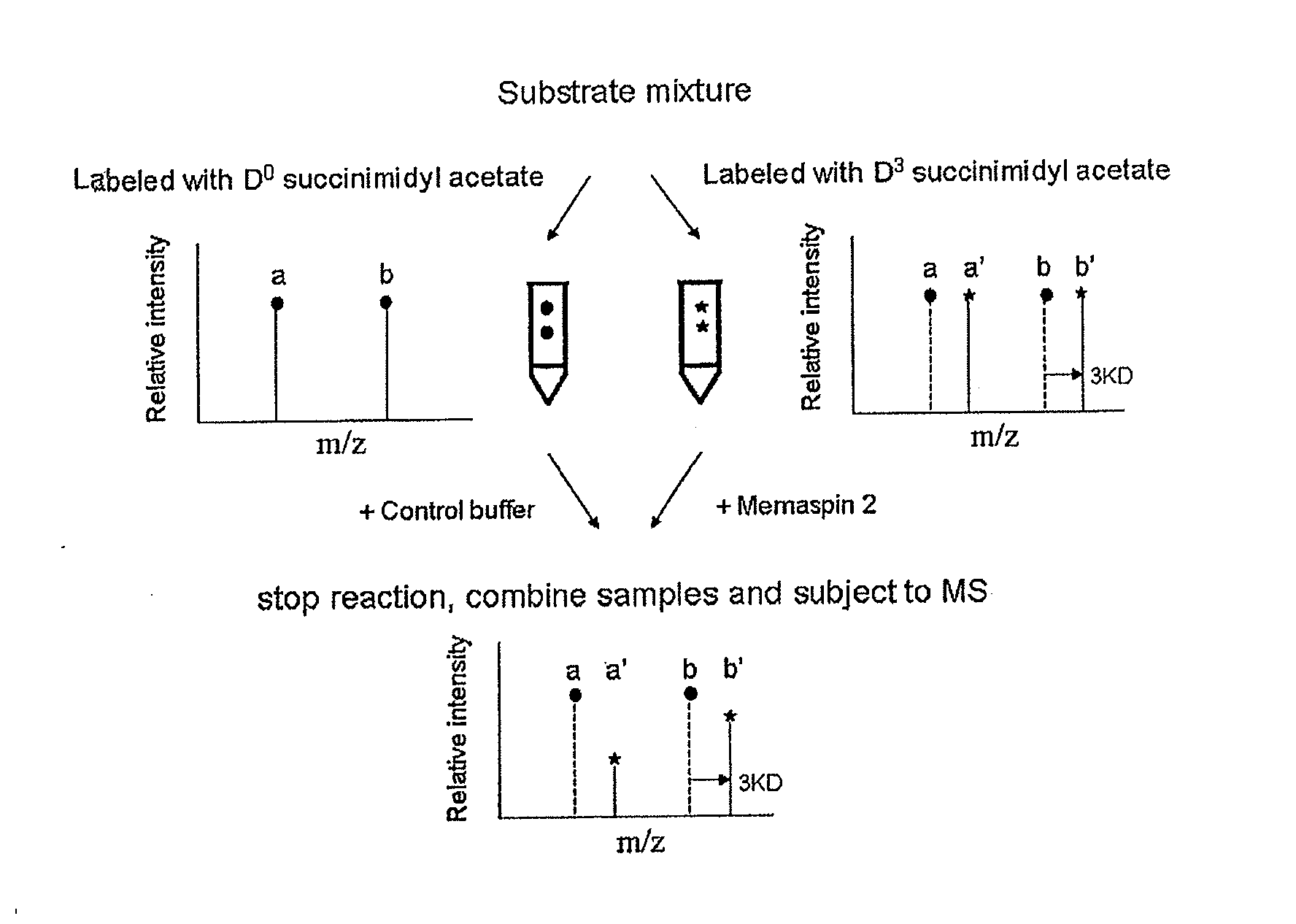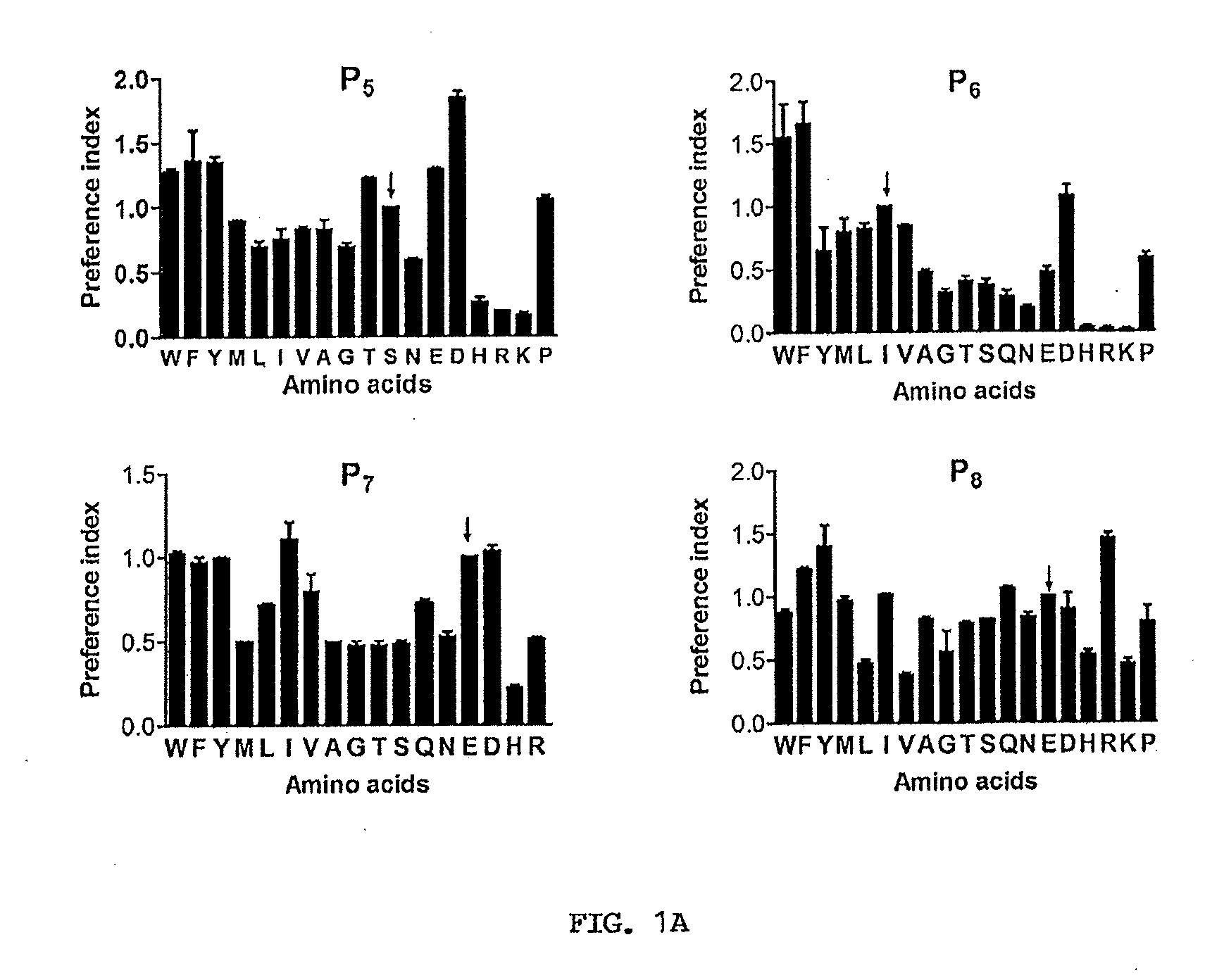Prediction of Memapsin 2 Cleavage Sites
- Summary
- Abstract
- Description
- Claims
- Application Information
AI Technical Summary
Benefits of technology
Problems solved by technology
Method used
Image
Examples
example 1
Materials and Methods
[0038]Materials. α-cyan-4 hydroxycinnamic acid, D0- and D6-form acetic anhydride , N-hydroxysuccinimide were purchased from Sigma. Peptide (Des-Ser1)-Cerebellin was purchased from Bachem (Bubendorf, Switzerland). All peptides derived from memapsin 2 potential substrates were synthesized by GenScript (Piscataway, N.J.). The ecto-domain of human memapsin 2 was expressed and purified as described previously (Hong et al., 2000). Monoclonal anti-memapsin 2 antibody 3E7 was purchased from Santa Cruz Biotechnology Inc (Santa Cruz, Calif.). Monoclonal anti-APP antibody 1560, MAB348 and polyclonal anti-APP antibody 5352 were purchased from Millipore (Billerica, Mass.). Monoclonal anti-actin antibody was purchased from Abcam (Cambridge, Mass.).
[0039]Design of the defined substrate mixtures. Peptide sequence RK (P10)T(P9)E(P8)E(P7)I(P6)S(P5)E(P4)V(P3)N(P2)L(P1)D(P1′)A(P2′)E(P3′)F(P4′), corresponding to the amino acid sequence of APP with Swedish mutation (APPSW) from P10 t...
example 2
Results
[0045]Complete residue preference on subsites P5-P8. In order to assess the contribution of all subsites on memapsin 2 catalysis, one needs a complete set of subsite specificity data. Although the complete residue preferences for eight subsites, from P4 to P4′ were available (Turner et al., 2001), only partial residue preferences had been determined for subsites P5 to P7 and there was no information on subsite P8 since these four subsites were discovered later (Turner et al., 2004). Thus, the first task was to determine the complete residue preference in these four subsites. The strategy used for these experiments was as previously described. Briefly, the initial cleavage rates of peptide substrates in a mixture by memapsin 2 were determined using ESI-TOF mass spectrometry. The relative rates under the experimental conditions were proportional to the relative kcat / KM (Preference Index) values. Thus, peptide substrates differing from one another only by residues in a single su...
example 3
Discussion
[0052]The determination of subsite specificity of aspartic proteases usually requires many kinetic analyses. Since most of these proteases have eight or more subsites and have non-stringent specificity, very few subsite specificity of these enzymes have been completely determined. For memapsin 2, the residue preference, expressed as relative kcat / KM values, is now known for twelve subsites, from P8 to P4′. Therefore, these data on memapsin 2 represent the first complete kinetic assessment of the subsite preference of an aspartic protease and offers a new opportunity to dissect the influence of subsite residues on its hydrolytic activity. The test of the general applicability of the subsite specificity information was done in two parts. The relative kcat / KM values of thirteen peptides of memapsin 2 substrates, or study set, were first determined. Using these data as guide, an algorithm was developed to quantitatively assess any new site for memapsin 2 cleavage activity. The...
PUM
 Login to View More
Login to View More Abstract
Description
Claims
Application Information
 Login to View More
Login to View More - R&D
- Intellectual Property
- Life Sciences
- Materials
- Tech Scout
- Unparalleled Data Quality
- Higher Quality Content
- 60% Fewer Hallucinations
Browse by: Latest US Patents, China's latest patents, Technical Efficacy Thesaurus, Application Domain, Technology Topic, Popular Technical Reports.
© 2025 PatSnap. All rights reserved.Legal|Privacy policy|Modern Slavery Act Transparency Statement|Sitemap|About US| Contact US: help@patsnap.com



